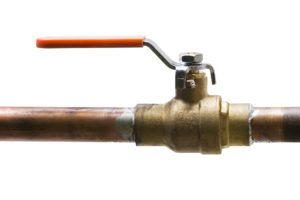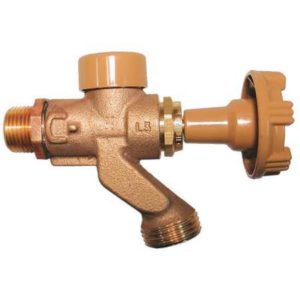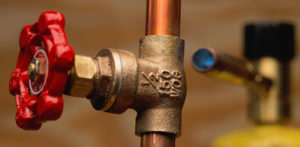
2. Disconnect
Whether you have a freeze proof hose bib (or anti siphon hose bib) or not, it is very important to remove hoses from the spigot during the winter. Not removing hoses or any other connections from the hose bib can trap water and can therefore surely cause the fixture to freeze. This is always a difficult step to take because most people will want to use the outside water until the very point when the freezing weather begins. It’s best to preempt the cold weather by disconnecting hoses early since even one night of freezing weather can cause a break in the pipes.
Anti Siphon Hose Bib


3. Inspect
The next step to winterizing outside faucets is leak detection and repair. Check all hose bibs, yard hydrants and other fixtures for leaks and drips. If you do find any leaks or drips repair or replace the fixture before the temperature drops to freezing. Water dripping, no matter how slowly, can block up and freeze in the pipe or fixture. Although a frozen outdoor faucet may not be apparent until the next season it may be possible to minimize the damage by repairing the leak before the winter.
4. Drain
Getting as much water out of the pipes is the second step to winterizing outdoor faucets. If you have a hose bib that is not freeze-proof the best way to do this is to shut off that line if possible and drain it down. If you cannot isolate the water supply to the hose bib to shut it off be sure to use extra insulation in the next step. For those of you who are go getters, you can go back to the shut-off valve in the house. Place a bucket or small container under the valve. You’ll find a cap or thumbscrew on the side of the shut-off valve. Remove it to allow a small amount of water to drain out.
5. Protect
The last step to winterizing outdoor faucets is to protect them with insulation. An easy way to do this is to install a hose bib cover on each outdoor fixture including frost free hose bibs. Hose bib covers are square or dome-shaped to fit right over outdoor faucets. They are made of thick foam so they are quite effective at keeping most of the cold away from the valve. When covering regular hose bibs that could not be drained extra insulation can be installed inside the hose bib cover to keep it warm and dry throughout the winter. In most situations, however, the hose bib cover will provide enough insulation. Frost free hose bibs should be covered as well because although they are resistant to freezing they are not completely frost proof in the coldest weather. There are rubber gaskets and washers inside the frost free hose bibs that will benefit from the extra protection from the cold that a hose bib cover can provide.
Hose bib covers can be found at most hardware or home improvement stores and are very inexpensive and easy to install. Covers can usually be reused for several years so they are a good long-term purchase. For just a few dollars per fixture, you can winterize outside faucets quickly and then move on to the other winterizing plumbing tasks that are necessary if you live in a cold climate. Don’t turn the shut-off valve back on until the spring, when you’re ready to de-winterize your hose bib.

With the water completely drained out of your hose bib, it’s now ready for the harsh cold of winter.









